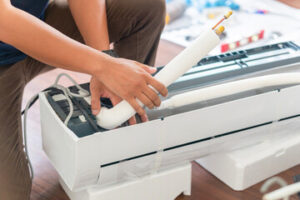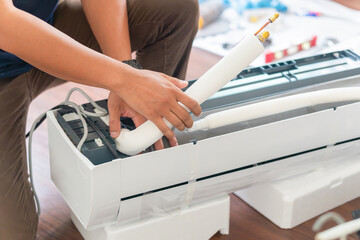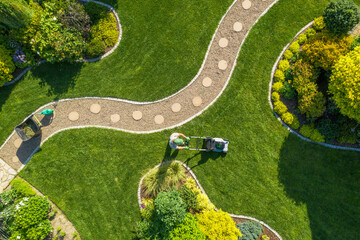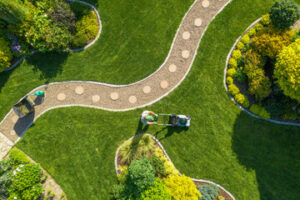The cool breeze from your air conditioning once felt like magic. But over time, even the most trusted units wear down. The air starts to feel warmer, and the noise becomes harder to ignore. That’s when the idea of replacement begins to settle in your mind.
AIR CONDITIONING REPLACEMENT LOVELAND OH is no small decision. It often comes with stress, cost concerns, and uncertainty. People usually hesitate, unsure if repair is still an option. But replacement is sometimes the only path to true comfort again.
Today, air conditioning systems have evolved. Newer technologies are changing how we cool our homes. These changes go beyond temperature control. They’re shaping how we live, save energy, and interact with machines.
A modern replacement isn’t just a machine swap. It’s a long-term investment in comfort and sustainability. Older units can cost more in the long run. New systems bring better efficiency, lower bills, and quieter operation.
One major shift is smart integration. Today’s units can sync with your phone. This allows scheduling, monitoring, and adjustments from anywhere. It adds convenience while saving energy when you’re away.
Another growing factor is adaptive cooling. Some systems now learn your patterns. They adjust cooling levels automatically based on your behavior. You don’t have to keep tweaking settings every day.
Even the design of air conditioning systems is changing. Manufacturers are considering visual appeal more than ever. Slimmer, quieter, and less visible options are in demand. The machine no longer has to be an eyesore.
In addition to aesthetics, eco-conscious buyers are asking for better refrigerant systems. Many are moving away from harmful materials. This protects the environment and often qualifies for energy incentives. Cooling can now be both powerful and responsible.
People replacing their air conditioners also ask about zoned cooling. This lets different rooms have different temperatures. It’s useful in large homes where not all areas need equal cooling. It avoids wasting power on unused spaces.
Installation is also transforming. Companies are now using sensors and mapping tools to plan layouts. This reduces mistakes and ensures efficient airflow. What once took hours now finishes quicker and with better results.
Ductless systems are gaining traction too. They are easier to install in older buildings or small spaces. They offer the same level of comfort without the hassle of major construction. These systems make upgrades possible for more people.
On the financial side, flexible payment plans are changing the game. More customers are choosing upgrades thanks to low-cost financing. This spreads the investment over time. It makes replacement less painful.
Noise reduction is another big focus in replacement choices. Quieter compressors and insulated panels are now common. Living spaces remain peaceful even when the unit runs on full power. That adds value beyond temperature.
Energy monitoring is a recent development. Some new units show you real-time power usage. This insight helps users understand how to manage cooling habits. Knowledge leads to savings.
There’s also innovation in predictive maintenance. Advanced units can alert you before problems occur. This minimizes unexpected breakdowns. It keeps the system running longer with fewer issues.
People now consider air quality when replacing systems. Filters have improved dramatically. They can trap pollutants, allergens, and odors. It turns your air conditioner into a health tool.
Replacing an old unit can also impact resale value. Buyers prefer homes with modern, efficient systems. It shows care and reduces future repair worries. Sometimes, the return is more than just comfort.
Installation experts are changing their approach too. Training now includes digital diagnostics and customer education. Technicians explain more and make personalized suggestions. This enhances trust and decision-making.
Many are also interested in energy recovery systems. These transfer excess heat for other uses like water heating. It’s an efficient way to repurpose waste energy. Home systems are becoming smarter and more integrated.
Another fresh idea is modular cooling. This lets you expand your cooling system later without starting from scratch. It’s great for growing families or future renovations. Flexibility is key in modern setups.
Voice control is entering the scene as well. People now operate their cooling systems using smart speakers. It adds accessibility and a futuristic feel. Home management becomes even more seamless.
System diagnostics have improved massively. Technicians can run complete health checks using software. This speeds up problem identification. You get solutions faster and with less guesswork.
Some replacement projects are now bundled with insulation upgrades. It makes sense to improve overall home efficiency. Better insulation means your new unit works less. That extends its life and lowers costs.
The growing use of solar-ready systems is also changing decisions. Homeowners can prepare for future solar installations. Some systems already include compatible features. This positions them for an eco-friendly future.
User preferences are being built into replacement decisions. You can now choose units with custom fan speeds, colors, or sound levels. Cooling becomes a more personalized experience. It’s no longer one-size-fits-all.
As weather patterns shift, cooling demand is changing too. Units must now withstand longer periods of heat. Manufacturers are developing stronger and more reliable compressors. Resilience is becoming a core feature.
Upgrading your system also invites a chance to declutter. Modern units often take up less space. You can remove old ductwork, free up storage areas, or rearrange rooms. It’s more than just air—it’s lifestyle reorganization.
Sensors now play a larger role in replacement decisions. Some detect humidity, motion, or air purity. They allow systems to react based on real-time conditions. Your home adapts to you automatically.
Hybrid systems are entering more homes now. These combine cooling with ventilation or dehumidification. One device handles multiple comfort needs. It reduces device count and streamlines control.
Some new systems allow remote diagnostics from service centers. Help can arrive faster and with better preparation. This reduces downtime and stress during hot days. Support is becoming more proactive.
The replacement process now often includes software updates. Like phones or laptops, air conditioners can improve over time. New features or better energy performance may arrive through a simple update. This makes the system feel future-proof.
Thermal zoning is also improving. Newer systems detect which part of your home needs more attention. They direct airflow only where needed. It saves power and keeps comfort consistent.
Some homeowners choose to replace systems based on sustainability goals. They want to reduce their carbon footprint. New systems support those values better. It becomes a climate-conscious decision, not just a technical one.
Customer expectations are higher now. People want installations to be fast, clean, and well-explained. Companies are adapting with better tools and training. The whole process is more pleasant than it used to be.
Cooling systems are also becoming more compact and mobile. Some replacements are on wheels or easy to relocate. These suit smaller homes or apartments. Flexibility is starting to beat permanence.
Innovators are exploring noise-canceling technology in systems. Instead of just lowering noise, some units cancel it out. This offers ultra-quiet operation even in tight spaces. You enjoy peace along with cool air.
People now care more about long-term ownership costs. They ask about spare parts, warranties, and service options. It’s no longer just about the sticker price. Knowledge is part of the replacement journey.
Visual feedback is being added to some systems. LED indicators or digital displays show status clearly. This avoids confusion and builds user confidence. You’re never left guessing what’s happening.
The future might even bring self-cleaning systems. Some experimental units already remove dust automatically. This reduces the need for regular maintenance. It keeps airflow clean and strong.
As urban living changes, rooftop and wall-mounted systems are rising in popularity. These options save floor space. They also blend into modern architecture better. Form and function are balancing out.
Replacing your air conditioning unit is no longer a chore. It’s an opportunity to upgrade comfort, control, and conscience. As technology advances, so do the reasons for replacement. It’s more than a machine—it’s a move toward smarter living.
This evolving landscape is filled with possibilities. Each decision brings better air, lower bills, and future-ready features. The old approach to cooling has melted away. A new era of intelligent comfort has arrived.


